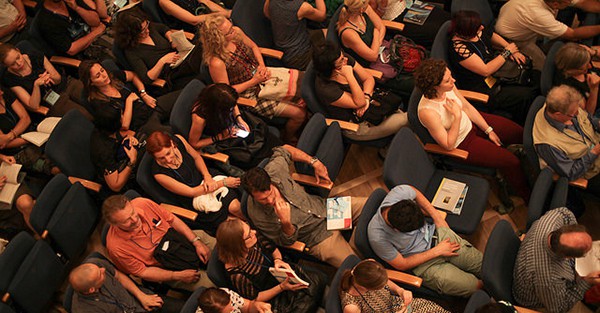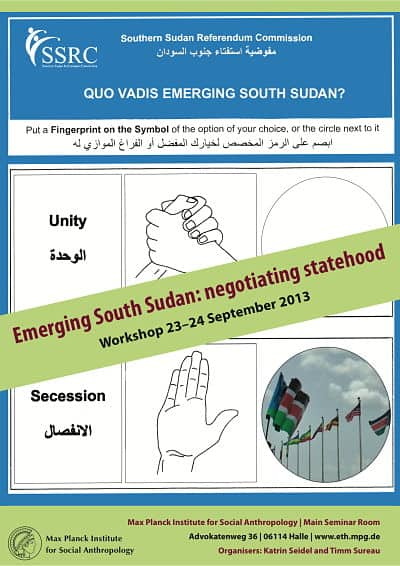A week after the EASA conference in Tallinn, the impact of Elisabeth Povinelli’s keynote lecture may seem less urgent to debate, after so many panels, plenary sessions, parties, lively discussions in various settings and more massacres in Gaza. Having been a guest of Allegra at Tallinn, I would like to continue the discussion started by this post, from my semi exterior view point of a sympathetic observer of the field.
Seen from the balcony, it is clear that the lecture, as a performance, was a failure. Prof. Povinelli failed to capture the attention of the audience that massively left the room at question time. To a large extent, this is could be due to the setting of the lecture: it is immensely difficult to create and convey a sense of intimacy, while performing alone on the stage of a national concert hall in front of about 900 colleagues. What might have functioned in a smaller room, clearly did not in such a wide space.
Her excessive use of body language may indicate that she was herself aware of the need to occupy the stage, by stretching her arms towards the center to emphasize some notions (often not the most complicated ones) and frequently touching her hair to reassert her own importance as the invited lecturer – although my impression here could be the effect of a transatlantic cultural misunderstanding.

The final technical failure was certainly the most embarrassing of them all. By showing the soundless images, and commenting on the aborigines she had directed in her film, she literally appeared to have suppressed their voices while manipulating their actions – certainly the last thing on earth she would have wanted to do.
So what went wrong? Since I probably missed some crucial articulations of her speech, I shall not pronounce myself too strongly on the contents of her performance. I can only say that I was uneasy with many of the concepts she developed – for instance, the notion that her interactions with the aborigines she studies could be described as a “collaboration”, while she admittedly “wrote the script” of a movie that she was proud to be the “director” of. These two positions are not easily reconcilable. This might be what she attempted to do by using the notion of an “alteration”, that could be symmetrically applied to her own self, and to the community she observed. Yet, alteration is the lowest degree of transformation; it affects any partner of any interaction, and may transform them in whatever direction – hence, her use of this concept might as well be rendered by speaking of a process of “whateverification” (transformation in whatever direction).
I suspect that the audience expected some more critical awareness of the very different “alterations” that took place in her fieldwork.
In my understanding, the conference went wrong from the moment she decided that “intimacy”, being one of the conference’s main themes, could be applied to her own research experience, and that her “collaboration” with those distant locals could be fascinating enough to be the subject matter of her lecture – in a word, that she was important enough to be herself the subject matter of her lecture. As I was told, she has written some amazingly sophisticated books. Yet, in Tallinn, we were appalled by her lack of critical reflexivity on either the use of new technologies, or on the position of the anthropologist vis-à-vis her fieldwork.
What might have functioned in a class room at Columbia was just out of place at the Estonian national concert hall. This was just not the proper setting to expose her intimacy.
The conversation continues here.






I was not at EASA so cannot comment on the presentation itself but I can testify to the deeply collaborative processes that this film project is part of.
I worked under Povinelli at UChicago for many years. She’s brilliant but not too easy to grasp (whether in speech or writing). That’s probably due to the elusive nature of the Lacanian-Deleuzian thinking that inspires her work. Ironically, French post-strucuturalism, which marks much of American “cutting edge” anthropology, is not as keenly embraced in Europe, not even in France where Piron, the harsh author, is based… It baffles me that a discipline that sees itself as the epitome of reflexive cosmopolitanism falls pray to such nationalistic differences of thinking…
I was one of the few people who didn’t find the talk problematic, not having read anything by Povinelli until now, her talk inspired me to learn more about her work. As someone who feels a strong commitment to my field site and the people there, I was impressed by her on going work in the same site for decades, which is becoming more and more rare among anthropologists. Her work struck me as collaborative.
All the talk about the technical failure, really, it was not her fault and making it a point about lack of true collaboration cause we could not hear the voices of the informants in the film, is, IMO, stretching it too far. What I am more fascinated by is the anthropological rumor mill that by the day 4 of the conference had attributed so many negative characteristics to her talk and performance that I wondered if maybe these people were not watching a different talk than I was.
And as far as question time, EASA key note address (like at many other conferences) is never really the best setting for discussion.
For those interested in finding out a little more see http://blogs.abc.net.au/nt/2012/01/nt-short-at-berlin-international-film-fest.html?site=darwin&program=darwin_drive/
Let’s reflect on this: someone who claims to be student of Povinelli — a reflection of her pedagogy — has responded to this post by essentially asserting:
1) You Europeanist are just too parochial to understand Povinelli’s “edgy” Deleuzian-Foucaudian Post-Structuralist anthropology!
2) This is ironic, because the creme-de-la-creme of American anthropology is deeply immersed in a French philosopher tradition — apparently more so than even the French themselves?
3) If only the silly, backwards, ill-informed Europeanist would read their own damn European philosophers, perhaps they might have a better understanding of what Povinelli was saying to them!
I must say, this sort of patronizing attitude almost certainly contributes to the gulf between Povinelli and EASA members. If you do not respect the people you are in conversation with, it will show. The fact that the above poster thinks very little of his/her European colleagues, for example, is made abundantly clear in the post above. And if this viewpoint reflects even a fraction of how Povinelli relates to Europeanists, than it should be no surprise to anyone that her keynote did not resonate with EASA members.
This is a remarkably creative reading of an otherwise straightforward comment. I don’t agree with Mr. D’Andrea, but you’ve managed to add a number of things to his argument that aren’t actually there. I can only guess as to why.
He says Povinelli’s work is difficult to grasp and elusive. Nowhere does he say it’s difficult for Europeans, but not for Americans. He says Europeans do not “keenly embrace” post-structuralist thought. That’s a debatable claim, to be sure, but certainly nothing like what you make of it in your 3rd point.
In any case, if one cares to perpetuate pointless stereotypes, one could just as well read Povinelli’s attachment to Deleuze as a symptom of an AMERICAN inferiority complex. Use of Foucault in the US was read in those terms. So was the use Derrida (and Levi-Strauss, and Latour. etc.). It’s actually a very banal cycle: American anthropologists start using a European philosopher in earnest; others fret that its being taken out of context, and if only we understood all of the last 100 years of French thought, etc, etc. etc. It’s the story of the AAA’s for the past four decades.
And by the way, everyone knows that famous European scholars NEVER act in patronizing ways. Nor do they give jargon-laden conference papers.
“It baffles me that a discipline that sees itself as the epitome of reflexive cosmopolitanism falls pray to such nationalistic differences of thinking…” Go on, then.
At that stage of the discussion, a post-scriptum could be useful. I didn’t mean to discuss the contents of the lecture, but only explain why it failed as a performance, since I frankly was at a loss to understand what the point of the talk was. The description of the short film provided by Tess is indeed miles away from the impression I received.
As for the Deleuzian reference, I didn’t want to mention it since I know too little of Povinelli’s books (I only read a couple of interviews to try and make sense of what I had heard). Here is my french point of view on what she does with it. When I was a student, in the early 90’s, I read a lot of Deleuze&Guattari, trying to understand how my parents’ generation could have taken it seriously as a “political” reflection. To use a rough metaphor, it sounded like psychedelic guitar heroes in the age of the grunge. Yes, Deleuze is a fantastic philosophical guitar hero, but his experiments at a Nietzscheo-Freudo-Marxian synthesis could not be the common ground of a comparative reflection on societies and cultures that required a more steady beat. For that purpose, in the “French theory” supermarket, I would rather recommend a section comprising Castoriadis, Clastres and Gauchet, with Louis Dumont on a different shelf. To me, what Povinelli does with Deleuze and Lacan is like a clever DJ mixing slightly exotic and beautiful jingles with new sounds and rythms. I am not certain how useful is this operation to the understanding of the world we are in, but this decontextualisation is surely is not unfair to Deleuze&Guattari, since “jingle” (“ritournelle” in French), was one of their favorite notion.
The ‘steady beat’ required on the reflection above would then be more like Phil Collins or maybe some Euro-pop trash, a shame to have Dumont in such a party.
I can’t speak to the ‘Povinelli Performance Piece’ or the use of the film as a prop/representation/evidence, but I can question the relevance of the performance to the European anthropological tradition – or at least that aspect of it that emerged prior to the Tallinn Walkout. I mean a critique of the Povinelli Performance Piece is one thing, but what of the role of EASA as the conference organisers, the audience and indeed the Piron Poster? What are they all protesting? Is this the cutting edge of – albeit-interdisciplinary, anthropology?
Sylvain Pyron I think does raise important questions regarding collaboration, intimacy and her lack of critical reflexivity on use of new technologies and the position of the anthropologist, BUT what should we other “othered,” who are neither European nor American, make of all this? If we cannot understand the use of language – technical or otherwise, or indeed the nuances of gesture, the contexts of action, how can we make these contesting subaltern voices heard?